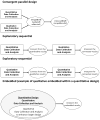Mixed methods in biomedical and health services research
- PMID: 23322807
- PMCID: PMC3569711
- DOI: 10.1161/CIRCOUTCOMES.112.967885
Mixed methods in biomedical and health services research
Abstract
Mixed methods studies, in which qualitative and quantitative methods are combined in a single program of inquiry, can be valuable in biomedical and health services research, where the complementary strengths of each approach can yield greater insight into complex phenomena than either approach alone. Although interest in mixed methods is growing among science funders and investigators, written guidance on how to conduct and assess rigorous mixed methods studies is not readily accessible to the general readership of peer-reviewed biomedical and health services journals. Furthermore, existing guidelines for publishing mixed methods studies are not well known or applied by researchers and journal editors. Accordingly, this paper is intended to serve as a concise, practical resource for readers interested in core principles and practices of mixed methods research. We briefly describe mixed methods approaches and present illustrations from published biomedical and health services literature, including in cardiovascular care, summarize standards for the design and reporting of these studies, and highlight four central considerations for investigators interested in using these methods.
Conflict of interest statement
Figures
Similar articles
-
Research dissemination reports.Hong Kong Med J. 2013 Jun;19 Suppl 4:3. Hong Kong Med J. 2013. PMID: 23775177 No abstract available.
-
Research dissemination reports. Introductory editorial.Hong Kong Med J. 2011 Dec;17 Suppl 6:3. Hong Kong Med J. 2011. PMID: 22147350 No abstract available.
-
Health computing for Intelligence of Things.Technol Health Care. 2019;27(5):455-457. doi: 10.3233/THC-191746. Technol Health Care. 2019. PMID: 31156194 No abstract available.
-
Qualitative Research in Transplantation: Ensuring Relevance and Rigor.Transplantation. 2016 Apr;100(4):710-2. doi: 10.1097/TP.0000000000001117. Transplantation. 2016. PMID: 26910328 Review. No abstract available.
-
Participatory action research.J Epidemiol Community Health. 2006 Oct;60(10):854-7. doi: 10.1136/jech.2004.028662. J Epidemiol Community Health. 2006. PMID: 16973531 Free PMC article. Review.
Cited by
-
Facilitators and barriers in anorexia nervosa treatment initiation: a qualitative study on the perspectives of patients, carers and professionals.J Eat Disord. 2021 Feb 27;9(1):28. doi: 10.1186/s40337-021-00381-0. J Eat Disord. 2021. PMID: 33640028 Free PMC article.
-
Bouncing forward of young refugees: a perspective on resilience research directions.Eur J Psychotraumatol. 2013 May 2;4. doi: 10.3402/ejpt.v4i0.20124. Print 2013. Eur J Psychotraumatol. 2013. PMID: 23671759 Free PMC article.
-
Implementation fidelity of a strategy to integrate service delivery: learnings from a transitional care program for individuals with complex needs in Singapore.BMC Health Serv Res. 2019 Mar 19;19(1):177. doi: 10.1186/s12913-019-3980-x. BMC Health Serv Res. 2019. PMID: 30890134 Free PMC article.
-
Achieving integration in mixed methods designs-principles and practices.Health Serv Res. 2013 Dec;48(6 Pt 2):2134-56. doi: 10.1111/1475-6773.12117. Epub 2013 Oct 23. Health Serv Res. 2013. PMID: 24279835 Free PMC article.
-
Leadership development in complex health systems: a qualitative study.BMJ Open. 2020 Apr 6;10(4):e035797. doi: 10.1136/bmjopen-2019-035797. BMJ Open. 2020. PMID: 32265250 Free PMC article.
References
-
- Creswell JW, Plano Clark VL. Designing and Conducting Mixed Methods Research. 2. Thousand Oaks, CA: Sage; 2011.
-
- National Institutes of Health. [Accessed on March 2, 2012];Funding Opportunity PA-11-063. http://grants.nih.gov/grants/guide/pa-files/PA-11-063.html.
Publication types
MeSH terms
Grants and funding
LinkOut - more resources
Full Text Sources
Other Literature Sources


